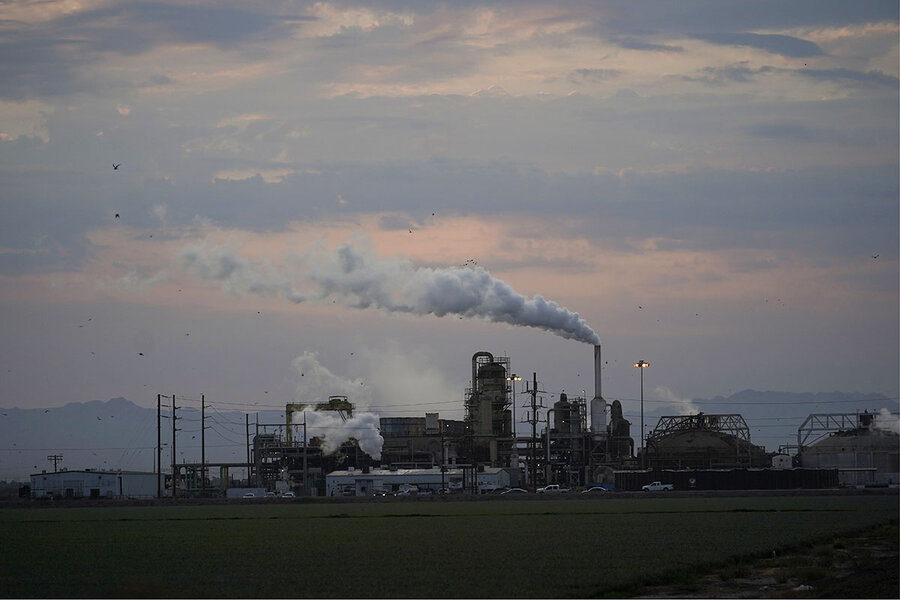Clean energy depends on lithium. Can California supply it?
Loading...
| Pasadena, Calif.
As the United States seeks to wean itself from fossil fuels, attention is turning to California and its vast reservoir of lithium – an essential component of rechargeable batteries used for electric vehicles, mobile phones, and to store energy from wind and solar power.
The world is clamoring for lithium. So much so that its price rose more than 400% in 2021. Now several companies are working to extract lithium from Southern California’s Imperial Valley. There, deep below a large shallow lake called the Salton Sea, lies the world’s biggest reservoir of brine that contains lithium. The brine is in ancient geothermal areas that predate the existence of the sea, which was created by an engineering accident in early 1900s efforts to divert Colorado River water for irrigation.
Known as “the Saudi Arabia of lithium,” California has the potential to more than meet demand in the U.S., which relies heavily on a vulnerable international supply chain that includes China.
Why We Wrote This
Lithium is a key component in clean energy efforts around the world. California could supply vast quantities of the metal with minimal environmental damage. But can it act quickly enough?
How important is lithium to the future of clean energy?
Demand for lithium is expected to skyrocket. By 2045, California, the world’s fifth-largest economy, is mandated to have a completely renewable-energy electrical grid, which will require more large lithium batteries for electricity storage. Additionally, the state will no longer allow the sale of new gasoline-powered cars by 2035 – a huge impetus for automakers to switch to electric vehicles that need lithium batteries.
Almost all of the components of these batteries can be substituted, but lithium is irreplaceable because of its light weight, writes research scientist Michael Whittaker, in an email to the Monitor.
“As battery demand grows exponentially, so does the demand for lithium,” says Dr. Whittaker, describing the metal as “essential to the future of clean energy.” The materials expert is the director of the Lithium Resource Research and Innovation Center at the Lawrence Berkeley National Laboratory in California.
Most lithium today is mined in Australia, Chile, China, and Argentina. It’s extracted either with hard-rock blasting and acid dissolution that leave behind toxic materials or through vast, desert-land-consuming evaporation ponds.
What is the potential role of California in lithium production?
The appeal of extracting lithium from the Imperial Valley – dubbed Lithium Valley – is that it would avoid the supply chain issue and its negative environmental effects, including transport, says geochemist Michael McKibben, professor emeritus at the University of California, Riverside.
He sees “very little environmental problems” associated with the direct extraction of hot, geothermal brine in the Salton Sea area, where the brine is already being pulled up at 11 existing geothermal power plants operating in the valley. Lithium extraction could be added to those operations.
The power plants drill down and bring up the hot brine. Steam from the brine turns turbines that produce electricity. The brine is then injected back down into the earth to refill the reservoir. It’s a renewable form of energy whose main byproduct is water vapor. Lithium would be filtered from the brine before it’s returned to the reservoir.
The brine “would supply all of the U.S. needs for the foreseeable use of lithium,” says Dr. McKibben. “We could become an exporter. If we produce at the maximum, the U.S. could end up dominating the global lithium market.”
What are the impediments to developing California’s lithium?
The biggest hurdle is that the technology to filter lithium from brine is just now being developed. Three companies involved in geothermal power generation in the Imperial Valley are actively working on piloting lithium extraction and scaling it up for commercial use. The state and federal government are also supporting this lithium effort.
One company, Australia’s Controlled Thermal Resources Ltd., expects to start producing lithium in 2024, and is backed by investors including General Motors. Another, Berkshire Hathaway Energy Renewables, is being helped by a $6 million matching grant from the California Energy Commission to start a pilot extraction facility that, if successful, would put it on a path to commercial production by 2026. A third company, EnergySource Minerals, is already piloting lithium production and plans to scale it up soon.
Timing is important, says Dr. McKibben, because “the auto manufacturers want that lithium right now, and they would like it to be free of international supply chain issues.”
Questions remain about the community in which this work would be done, say both Drs. McKibben and Whittaker. Imperial County, largely agricultural, is the poorest county in the state. Can it supply a workforce to build and operate more geothermal plants (necessary to meet the state’s 2045 electric-grid mandate), lithium extraction operations, and lithium battery manufacturing; expand a road and rail network; and put up more housing – all sustainably?
The community, struggling with unrelated health issues from the receding Salton Sea, has mixed feelings about it. A local nonprofit that advocates for disadvantaged groups “applauds” state and federal efforts in the valley to address climate change. But the path to that green economy “begins and ends with achieving greater environmental justice for frontline communities,” said Luis Olmedo, director of Comite Civico Del Valle, in a statement last month.
Editor’s note: The information about Berkshire Hathaway has been updated.






